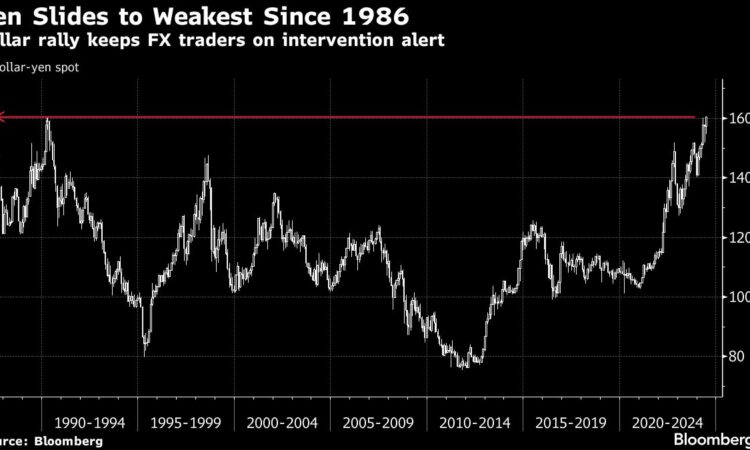
(Bloomberg) — A grim reality is setting in for Japanese authorities as the yen plunges through milestone levels in rapid succession: The slide won’t stop until the Federal Reserve relents on its higher-for-longer policy path. And they have no control over that.
Most Read from Bloomberg
It’s a realization shared by global investors as they parse the way still-high US borrowing costs buoy the dollar — and the impact that has on the rest of the world. In the $7.5-trillion-a-day market for global currencies, the yen’s relentless rout offers an extreme manifestation of US financial dominance.
“It’s all about the Fed. Higher for longer is keeping the front end of rates very high, drawing money into the US and keeping the dollar strong,” said Andrew Brenner, head of international fixed income at NatAlliance Securities LLC. For Japan, “it’s a problem.”
The US’s dominance in global financial markets was on full display Wednesday. A key gauge of the dollar closed at a new year-to-date high, pressuring the rest of the world’s currencies. US stocks were on their way toward wrapping up another strong quarter, while the Treasury Department handily found buyers for $70 billion of notes it put up for auction.
It was a different story for the yen, which tumbled by as much as 0.7% to 160.87 per dollar, blowing past where officials intervened in the market in April. Against the euro, the Japanese currency dropped to a low of 171.80, the weakest on record. In the midst of these moves, Japan’s top currency official, Masato Kanda, reiterated that authorities are urgently watching the foreign-exchange markets and would take appropriate steps as needed.
The problem is, efforts by officials in Tokyo to prop up the yen so far have fallen flat. The Japanese currency has continued to weaken in the weeks since the Asian nation’s record ¥9.8 trillion (more than $60 billion) foray into foreign-exchange markets — and further intervention is likely to be just as ineffective, strategists said.
“I don’t see any of this working until the Fed actually eases,” said Bob Savage, head of markets strategy and insights at BNY Mellon Capital Markets in New York. “Big picture, you have to get the demand for dollars lower in Japan. You either get your long-end rates high enough, or you get US rates low enough. Neither of that is happening.”
Asset managers have been piling into bets against the yen, and last week were their most bearish in data going back to 2006, according to Commodity Futures Trading Commission figures released on Monday.
The yawning gap between interest rates in Japan — where borrowing costs remain near zero — and the US has been the central driver dragging the yen lower this year.
It’s not how things were expected to go. As the year began, traders were expecting the Fed to kick off a series of rate cuts, leading major central banks in a global easing trend even as the Bank of Japan went the other way to break from a policy of ultra-low rates. Instead, a robust US economy and sticky inflation has kept the Fed on hold, while the Bank of Japan moved forward with one meager increase.
“This is the year that the yen was supposed to rise along with Japanese interest rates,” said Kathy Jones, chief fixed-income strategist at Charles Schwab. But now, “the wait goes on,” she said.
A readout on the Fed Reserve’s favored US inflation gauge on Friday is now the next big catalyst for the yen. Economists expect core PCE inflation — a measure that excludes the volatile food and energy categories — will decelerate, which could bolster the case for the Fed to lower borrowing costs this year.
A lot is at stake for Japan. Citigroup estimates the country has $200 billion to $300 billion of ammunition to fund any further intervention campaign, which would entail selling US dollars and other currencies it holds in cash reserves or even government bonds around the world to buy yen.
Read: How to Tell If Japan Intervened to Prop Up the Yen: QuickTake
What Bloomberg Strategists Say…
“A breach of 163 for dollar-yen this week would probably do the trick for Japan’s Ministry of Finance as that would send realized volatility above 10% and the pair around 10 yen higher compared to May 16 lows.”
— Vassilis Karamanis, FX strategist
Read more here
For Dominic Konstam, any intervention is more about “slowing the process of the yen finding its ultimate bottom” as the Bank of Japan normalizes monetary policy.
“The problem that they’ve got are that they’re intervening on the wrong side,” the head of macro strategy at Mizuho Securities USA told Bloomberg Radio on Wednesday. “They’ve got limited reserves, they can’t spend hundreds of billions in terms of defending the currency.”
–With assistance from Naomi Tajitsu and Masaki Kondo.
(Updates pricing in fourth and fifth paragraphs.)
Most Read from Bloomberg Businessweek
©2024 Bloomberg L.P.
